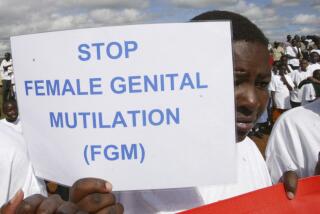Pediatricians’ group shifts in favor of circumcision
The American Academy of Pediatrics has shifted its official position on the contentious issue of infant circumcision, stating Monday that the medical benefits of the procedure for baby boys outweigh the small risks.
In its first new policy statement on the issue since 1999, the academy said that circumcision reduced risks of urinary tract infections in infants and of HIV and other sexually transmitted diseases later in life — and that the complications associated with the procedure were infrequent and mostly minor.
But the physicians’ group stopped short of recommending the sometimes controversial practice for all newborn boys, urging parents to be guided by their religious, ethical and cultural practices in addition to the science.
“This is a decision parents should make based on what they think is most important for their child’s welfare,” said Dr. Douglas Diekema, a pediatric emergency specialist and bioethicist at Seattle Children’s Hospital who was a member of the task force. “The [medical] benefit may not be so compelling when it’s stacked up against other considerations.”
The academy reexamines its policies on a regular basis, Diekema said. In 2005, it reaffirmed the 1999 guidelines, which acknowledged some potential health benefits of removing the foreskin of the penis but said that they did not outweigh risks.
But during the most recent review it became “pretty clear that there had been a lot of scientific literature that had not been reflected in 1999, and it was time for a revision,” he said.
The task force spent more than three years examining 1,031 peer-reviewed articles published between 1995 and 2010. The studies dealt with various aspects of male circumcision, including medical benefits, risks and complications; costs; cultural and religious influences; and effects on sexual function.
Some of the evidence hadn’t changed much since the earlier analysis, Diekema said, including results indicating that risks associated with infant circumcision were low.
But new data supporting the medical benefits were compelling, he added.
Three randomized controlled trials from Africa, for example, showed that circumcision reduced men’s risk of contracting HIV, the virus that causes AIDS. Additional research supported those findings.
Studies also linked circumcision to reduced risk of other sexually transmitted diseases, including herpes, syphilis and human papillomavirus, which is linked to penile cancer in men and cervical cancer in women.
The new policy is “a little bit of a stronger statement about the benefits,” said Diekema, who characterized the change as “a difference in tone more than anything.”
Experts said that most physicians were already aware of the growing evidence in favor of circumcision and that the new guidelines wouldn’t change much in doctors’ offices.
“From the perspective of most pediatricians, this is business as usual,” said Dr. Carlos Lerner, medical director of UCLA Children’s Health Center.
Circumcision has fallen out of favor with American parents over the last few decades, with rates falling from about 80% in the 1970s and 1980s to below 55% in 2010, according to the Centers for Disease Control and Prevention.
Some object to the procedure on the grounds that it is irreversible and performed without the patient’s consent. Opponents also argue that it is traumatic for the infant and impairs later sexual function, though the technical report accompanying the policy noted that the task force did not find evidence supporting that belief.
Other parents may decide against circumcision because they can’t afford it. Medicaid programs in 18 states — including California — as well as some health insurance companies have stopped paying for the procedure. Some people trace those decisions to the academy’s 1999 guidelines stating that circumcision is not necessary, Diekema said.
The new policy could bring about a shift in affordability. The guidelines now make plain that the benefits of circumcision are great enough to “justify access to this procedure for families choosing it and to warrant third-party payment for circumcision of male newborns.”
A study published last week in the Archives of Pediatrics and Adolescent Medicine attempted to tally the costs involved. Researchers calculated that if circumcision rates remained at current levels, the lifetime healthcare costs for all babies born in a calendar year would be about $211 million higher than if rates were the same as in years past.
The academy’s new policy urges physicians to inform parents “in a nonbiased manner” of all the benefits and risks of circumcision; to make sure parents understand that it is an elective procedure; and to teach new parents how to care for their newborn’s penis, whether it is circumcised or not.
The guidelines also emphasize that sterile techniques and effective pain management should always be provided.
More to Read
Sign up for The Wild
We’ll help you find the best places to hike, bike and run, as well as the perfect silent spots for meditation and yoga.
You may occasionally receive promotional content from the Los Angeles Times.











